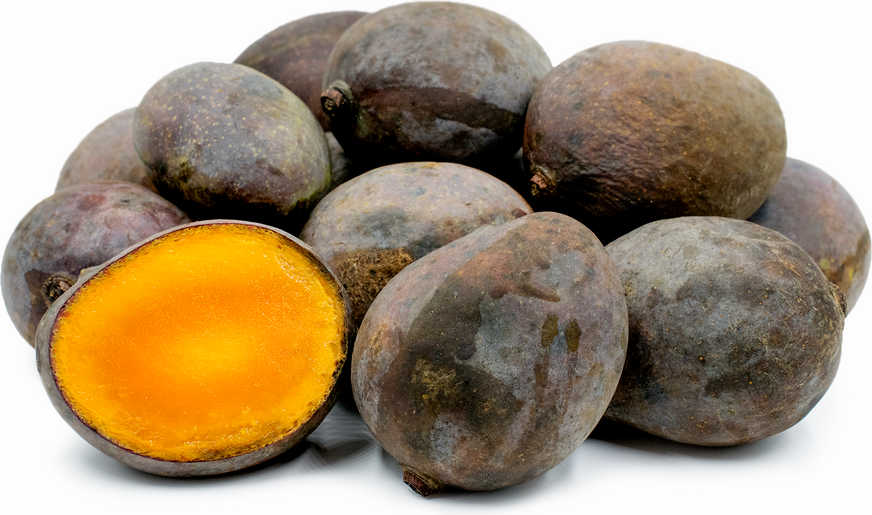


Kasturi Mangoes
Estimated Inventory, lb : 0
Description/Taste
Kasturi mangoes are a fruit with a distinctive dark purple hue that resembles a large plum. These mangoes are oval-shaped with a slightly pointed end and are more compact than other varieties, measuring approximately 4 to 6 centimeters in length and 3 to 4 centimeters in width. Initially green, the smooth skin of Kasturi mangoes darkens to a deep purple, almost black color as they mature, dotted with small white specks. Beneath its somewhat thick skin, the flesh is a vibrant deep orange, offering a juicy, non-fibrous texture that surrounds a relatively small seed. This seed takes up a significant portion of the fruit, considering its compact size, and is encased in a hard, woody husk that is oblong and flat. The flesh, which clings to the seed, can be challenging to separate cleanly. Kasturi mangoes are known for their sweet and slightly musky fragrance, and their flavor is equally sweet, featuring a rich, buttery flesh with hints of tropical fruits and floral notes.
Seasons/Availability
Kasturi mangoes are harvested from February to April in their native lands.
Current Facts
Botanically identified as Mangifera casturi and part of the Anacardiaceae family, Kasturi mangoes are a distinctive variety native to South Borneo, Indonesia. These mangoes, also known as Kastoori or Kastoree mangos, grow on trees that can reach up to 30 meters in height. Historically, Kasturi mango trees were part of the dense rainforest canopy in Indonesia. However, widespread logging and deforestation in Borneo have pushed many Indonesian mango varieties, including the Kasturi, towards extinction. This threat extends to related species such as Mangifera griffithi, Mangifera pajang, Mangifera quadrifida, and Mangifera torquenda. Sadly, the Kasturi mango is now extinct in the wild due to the extensive clearance of Kalimantan forests. Despite this, the fruit remains highly valued by the Banjar people of southern Borneo for its rarity.
Nutritional Value
Mangoes, including the Kasturi variety, are rich in vitamin C and provide substantial amounts of vitamin A, crucial for bolstering immune function, enhancing skin health, and supporting good vision. They are packed with polyphenols, plant-based compounds noted for their antioxidant properties, which help reduce oxidative stress. The flesh of Kasturi mangoes is particularly high in fiber, which is vital for digestive health, aiding in bowel regulation and helping maintain a healthy weight by promoting a sense of fullness. The leaves of Kasturi mangoes are valued in certain traditional practices for their medicinal properties, especially in managing diabetes. These leaves are thought to assist in regulating blood sugar levels, potentially affecting insulin levels and improving glucose tolerance, making them useful in diabetes management. The potassium found in mangoes plays a key role in managing blood pressure, crucial for preventing hypertension and reducing the risk of heart disease. To get the nutritional and medicinal benefits of Kasturi mangoes, they can be used in the form of tea or as powdered supplements.
Applications
Kasturi mangoes are primarily consumed fresh, with their skin peeled and seed removed. Although there is a high demand for the fresh fruits, they are also used to make jellies, nectars, syrups, and chutneys, albeit less frequently. The pulp blends well with other fruits in tropical salads or can be pureed for smoothies and juices. It also enhances sweet dishes like cheesecakes, tarts, sorbets, ice creams, puddings, mousses, and lassis. Kasturi mangoes are a flavorful addition to various baked goods. They pair well with ingredients such as coconut, lemon, lime, ginger, mint, chili, cilantro, vanilla, cardamom, yogurt, and rice. Kasturi mangoes can be stored for up to a week in the refrigerator or a cool, dry place.
Ethnic/Cultural Info
In Indonesia, the term "mangga" refers to mangoes, leading the Kasturi mango to be known locally as "Mangga Kasturi." The fragrance of this fruit has inspired cultural expressions, including an old song with the lyrics, “Seharum kasturi, seindah pelangi, semuanya bermula,” which translates to, “Oh, as fragrant as Kasturi, as beautiful as the rainbow, this love begins its journey.” Kasturi mangoes originate from the equatorial rainforests of Indonesia, a biodiverse region home to orangutans, toucans, and an abundance of wild flora and fauna, including up to 31 different mango varieties. Unfortunately, illegal logging has driven the Kasturi mango tree to extinction in the wild. Unlike other fast-growing tropical trees, Kasturi mangoes are not widely cultivated on large plantations in Indonesia due to their slow growth rate, leading to their cultivation on smaller farms instead.
Geography/History
Kasturi mangoes originate from the Indonesian region of South Borneo, known locally as Kalimantan, where they are primarily grown in the southern region. Cultivated by the local Banjar people, Kasturi mangoes are best suited to tropical and subtropical climates which provide the warm temperatures and high humidity necessary for their growth. Unlike most mango varieties, Kasturi mangoes are not commercially cultivated on a large scale; instead, they are typically grown for personal use or by small-scale farms. Although Kasturi mangoes are rare and have become extinct in the wild, their appealing flavor continues to drive commercial cultivation and growing interest in some non-native regions. Today, Kasturi mangoes continue to be cultivated by home growers and small farms within Indonesia, and can also be found in specialty stores, farmers markets, and tropical fruit farms in southern Florida and the Caribbean.
Recipe Ideas
Recipes that include Kasturi Mangoes. One
| Flavors of Mumbai |
|
Mango Mastani |
Podcasts




